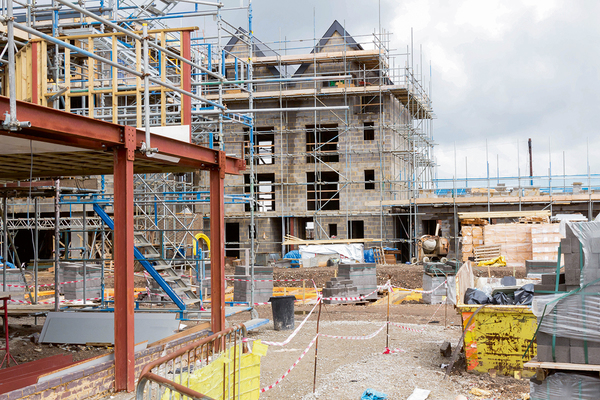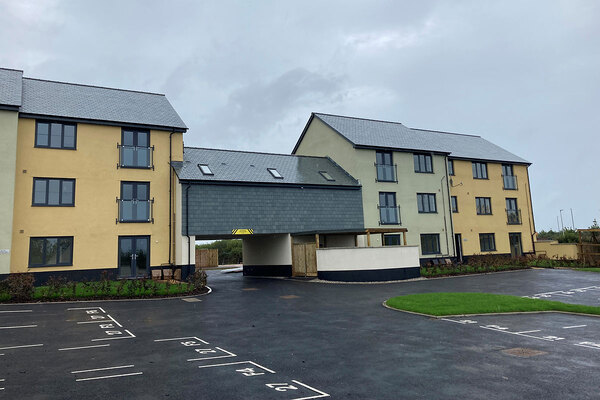You are viewing 1 of your 1 free articles
Housing market downturn ‘could cut Section 106 affordable housing delivery in half’
A market downturn similar to the one after the 2008 recession could see Section 106 delivery cut in half, a new report by housing consultancy Savills has warned.
The report, titled Affordable Housing: Building Through Cycles, found that housing associations were increasingly exposed to market downturns, based on trends in housing delivery post-2008.
Section 106 is a clause in planning legislation which requires developers to include a portion of affordable housing in their developments, which is then often sold to housing associations.
It is a primary driver of affordable housing delivery – with 45% of housing association homes (14,437) developed using the mechanism in 2016/17, according to figures compiled by the National Housing Federation.
Chris Buckle, director of residential research at Savills, said: “From the end of the last property cycle in 2007/08 we saw a roughly 50% fall in Section 106 affordable housing completions to fewer than 4,000 homes.
“Although we are not predicting a market downturn, the housing market is slowing and this could result in fewer Section 106 affordable housing completions.”
He pointed out that at the time of the last housing market downturn Section 106 made up only 19% of affordable housing starts in 2007/08, while today it makes up 53% of all affordable housing completions.
He added: “Therefore, affordable housing completions are much more exposed to a fall in Section 106 than before.”
The report, which will be published later today, said that housing associations need to reduce their reliance on Section 106 and lobby the government for further grant funding if they are to help successfully hit the government’s target of 300,000 new homes a year.
A total of 22,000 new affordable homes were delivered through Section 106 for the 12 months up to 31 March 2018, Savills said – 10% of all net additional dwellings in England.
This has grown over the past five years, when in 2012/13 Section 106 accounted for 4% of all homes delivered.
The report said this was due to big increases in affordable rent and shared ownership properties, which require less subsidy.
Historically low levels of grant have also seen a greater reliance on cross subsidy for housing associations and an increase in the number of homes organisations are delivering for private sale.
In 2017/18 housing associations increased the homes they built for market sale by just under 24% compared to the previous 12 months.
However, Savills estimated that of the 300,000 homes a year the government is targeting, 100,000 will need to be priced below market rates. In 2017/18 just 43,000 sub-market price homes have been delivered.
The report also estimated that the lifting of the Housing Revenue Account (HRA) cap for housing associations could result in 15,000 more council homes being delivered.
According to the Office for Budget Responsibility, scrapping the HRA borrowing cap would deliver an additional 9,000 homes over the next five years.
Introducing: The Developer
A guide to strategic partnerships and the deals announced so far
Under strategic partnerships, housing associations agree to increase their development programmes by a specified number of homes in return for extra funding for the government.
Unlike some other government funding programmes, they can use the new funding flexibly across their development programme, determining the tenure of affordable homes closer to completion following negotiations with Homes England.
The following housing associations were confirmed as strategic partners on 30 January 2019:
| Housing association | Grant | No of additional starts to March 2022 |
|---|---|---|
| Bromford | £66.4m | 1,400 |
| Curo and Swan | £51.1m | 1,067 |
| Liverpool Mutual Homes and Torus | £66.4m | 1,757 |
| Longhurst and Nottingham Community Housing Association | £71.7m | 1,685 |
| Together Housing Group | £53m | 1,152 |
| WHG | £38.7m | 1,000 |
| Yorkshire Housing | £61.8m | 1,300 |
| Your Housing Group | £87.5m | 2,315 |
Homes England announced the following partnerships in October 2018:
| Housing association | Grant | No of additional starts to 31 March 2022 |
|---|---|---|
| Guinness/Stonewater | £224m | 4,500 |
| Optivo | £44.9m | 1,000 |
| Orbit | £128.8m | 2,762 |
| Platform Housing Group | £71.8m | 1,800 |
| Southern Housing Group | £55.1m | 1,005 |
| Thirteen | £40m | 1,000 |
| Vivid | £88.2m | 1,408 |
Table published by Homes England on 31 October 2018
Homes England also earlier this year confirmed the following partnerships:
| Housing association | Grant | No of additional affordable starts to 31 March 2022 |
|---|---|---|
| EMH Group | £30.5m | 748 |
| Great Places | £29.2m | 750 |
| Home Group | £85m | 2,300 |
| Hyde | £95.4m | 1,623 |
| L&Q | £85m | 1,724 |
| Matrix Partnership | £77m | 2,257 |
| Places for People | £74m | 2,603 |
| Sovereign/Liverty | £111.5m | 2,275 |
Table published by Homes England on 3 July 2018











